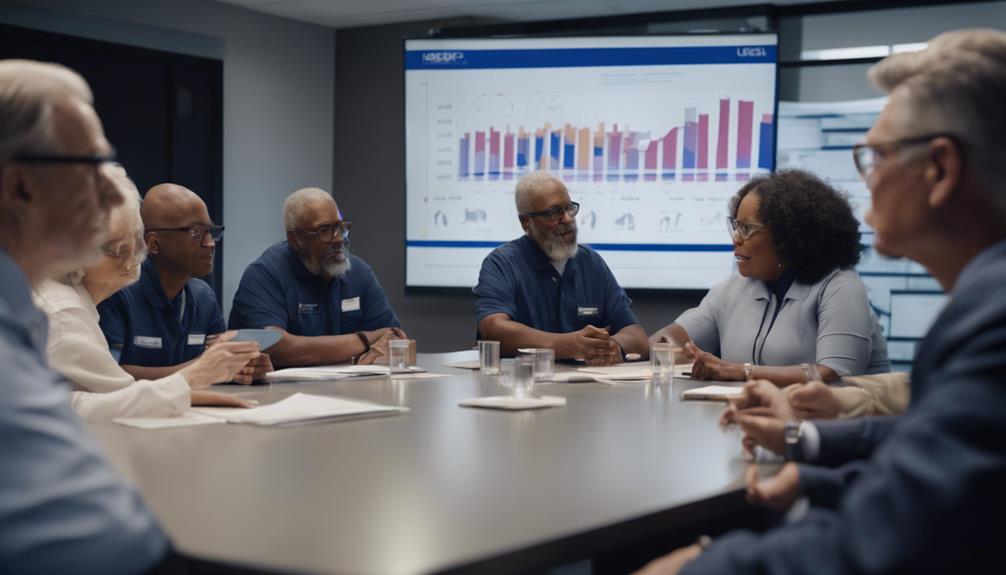To effectively navigate USPS retirement plans, it is important to understand the Federal Employees Retirement System (FERS), eligibility requirements, savings tools, Social Security benefit estimates, government aids, and cost of living adjustments. FERS, which was established for Federal employees in 1987, offers various retirement options based on age, years of service, and potential disabilities. Utilize savings planning sheets from the Department of Labor to establish goals and assess finances. Accurately estimate Social Security benefits to ensure retirement readiness. Utilize government resources for detailed benefits information. Take into account cost of living adjustments and carefully plan for a secure retirement. More information on USPS retirement planning is available for further insights.
Key Takeaways
- USPS retirement plans include FERS with Basic Benefit, Social Security, and TSP.
- FERS eligibility based on age, service years, and disability potential.
- FERS offers Immediate, Early, Deferred, and Disability retirement options.
- Federal retirement benefits eligibility varies based on age and service years.
- Utilize Department of Labor tools for savings planning and Social Security benefit estimations.
Understanding USPS Retirement Plans

To comprehend USPS retirement plans is to grasp a structured framework designed to provide financial security for postal employees post-career. Within the domain of Federal Employees Retirement System (FERS), eligible federal civilian employees are afforded the opportunity to participate in a detailed retirement package. This package includes benefits from the Basic Benefit Plan, Social Security, and the Thrift Savings Plan (TSP).
The TSP, in particular, serves as an essential component of the FERS retirement plan, offering employees the chance to invest in their future through various investment options.
Federal Employees Retirement System (FERS)

The Federal Employees Retirement System (FERS) is a retirement plan designed for Federal civilian employees. It commenced in 1987 to offer benefits through the Basic Benefit Plan, Social Security, and Thrift Savings Plan (TSP).
Eligibility for FERS benefits hinges on factors like age, years of service, and potential disabilities impacting retirement age requirements. The calculation of FERS benefits involves contributions to the Basic Benefit and Social Security components, with the TSP providing an opportunity for additional savings.
FERS Eligibility Requirements
Eligibility for the Federal Employees Retirement System (FERS) is primarily determined by a combination of age and years of service, with additional considerations for disability impacting age requirements.
Minimum Retirement Age (MRA) may apply for FERS benefits based on individual circumstances.
FERS offers four benefit categories: Immediate, Early, Deferred, and Disability retirement options.
Contributions are required for the Basic Benefit Plan and Social Security components of the FERS retirement system.
Detailed information on FERS eligibility criteria and benefits can be accessed through the FERS Information page.
It is essential for federal employees to understand how age, years of service, and potential disability affect their eligibility for different retirement options under the FERS program.
FERS Benefit Calculation
In calculating FERS retirement benefits, the formula takes into account the employee's years of service, the High-3 average salary, and a multiplier. The High-3 average salary represents the average of the highest three consecutive years of basic pay for federal employees.
The FERS multiplier, set at 1% per year of service, fluctuates based on the total years of service completed. Early retirement before reaching the Minimum Retirement Age (MRA) may result in reductions.
Federal employees eligible for FERS benefits also receive contributions towards Social Security and the Thrift Savings Plan (TSP). Understanding how these components interplay is essential for federal employees planning for retirement under the Federal Employees Retirement System.
Retirement Benefits Eligibility Criteria

Eligibility for USPS retirement benefits hinges on several key factors, including the individual's age, years of service, and the type of retirement plan selected. Understanding the specific age requirements, service years needed, and vesting period details is essential for USPS employees aiming to secure their financial future post-retirement.
Eligibility Age Requirement
Postal workers planning for retirement must carefully consider the age and service requirements associated with their chosen USPS retirement plan. The eligibility age requirement for USPS retirement benefits varies depending on the selected plan.
Here are some key points to keep in mind:
- FERS retirement benefits eligibility is determined by age and years of service, with a minimum retirement age (MRA) that may apply.
- CSRS retirement benefits are available to postal workers hired before 1984, with different age and service requirements compared to FERS.
- Disability may impact the age requirements for retirement benefits eligibility under both CSRS and FERS plans.
Understanding these age and service criteria is essential for effective retirement planning.
Service Years Needed
How many years of service are required for eligibility for USPS retirement benefits under the CSRS and FERS plans?
The CSRS plan mandates a minimum of 5 years of service for retirement benefits eligibility. On the other hand, FERS retirement benefits eligibility depends on the age and years of service of the employee.
Understanding the service years needed for retirement benefits eligibility is essential for USPS employees to plan effectively for their retirement. By meeting the required years of service, individuals can secure their eligibility for retirement benefits, ensuring financial stability in their post-employment years.
It is vital for employees to be aware of these eligibility criteria to make informed decisions regarding their retirement planning and to secure their future financial well-being. Understanding these criteria helps individuals align their financial goals with the available retirement benefits and make the most of the opportunities provided. By familiarizing themselves with retirement planning basics in India, employees can develop a comprehensive strategy that encompasses savings, investments, and pension schemes tailored to their needs. This proactive approach ensures a stable and stress-free post-retirement life. Additionally, staying informed about the latest updates and changes in retirement benefits is crucial to maximizing their advantages. Employees should also evaluate how often to review retirement plans to ensure they remain aligned with evolving financial objectives and life circumstances. Regularly revisiting these plans allows for adjustments and improvements that cater to changing needs, ultimately paving the way for a secure and enjoyable retirement.
Vesting Period Details
Understanding the requirements of the vesting period is essential for USPS employees to secure eligibility for retirement benefits under the USPS retirement plans. The vesting period typically ranges from 3 to 5 years of service. To become vested in the retirement plan, employees must work a certain number of years, ensuring they are entitled to receive retirement benefits upon meeting age and service criteria. It is important for employees to grasp these details to effectively plan for their retirement and secure their savings for the future.
- Employees must work a specific number of years to become vested.
- Vesting period typically ranges from 3 to 5 years of service.
- Once vested, employees are entitled to retirement benefits based on age and service criteria.
Savings Planning Worksheets and Tools

Looking to enhance your financial planning for retirement? Interactive savings planning worksheets provided by the Department of Labor can assist in managing your finances and starting a savings plan. These tools are designed to help individuals set saving goals, determine annual savings amounts, and organize financial documents to support their retirement plan.
By utilizing these worksheets, individuals can gain insights into their current financial situation, understand timelines for saving, and make informed decisions to achieve financial security in retirement. The tools offer guidance on how to develop a structured approach to saving, regardless of age and number of years until retirement.
Social Security Retirement Benefits Estimation

To plan effectively for retirement, understanding how to estimate Social Security retirement benefits accurately is essential.
You can begin receiving Social Security retirement benefits as early as age 62, but delaying them can lead to higher payments up to age 70.
Consider using Social Security benefit calculators to estimate your future benefits more precisely.
When planning for Social Security retirement benefits, also take into account potential spousal benefits that may be available to you.
It's advisable to explore detailed projections of your future benefits through Social Security resources for a more thorough understanding of what you can expect in retirement.
Government Retirement Benefits Resources

Government retirement benefits resources offer essential support for federal retirees managing post-employment needs and financial planning. Federal retirees can access benefits through the Civil Service Retirement System (CSRS) and the Federal Employees Compensation Act (FECA) Program. Detailed information about benefits for retired federal employees, including the Thrift Savings Plan (TSP), can be found on the Federal Employees Retirement System (FERS) Information page.
For inquiries regarding federal retiree benefits, individuals can contact the U.S. Office of Personnel Management. Various resources are available to help federal retirees navigate the benefits landscape, such as the Benefit Finder questionnaire and Benefits.gov. These tools assist retirees in understanding and accessing the benefits they are entitled to, supporting them in their post-employment financial planning.
Cost of Living Considerations and Planning

Considering the affordability of housing, groceries, healthcare, transportation, and other essential expenses is important when planning for retirement. It is vital to evaluate how these factors will impact your retirement income and overall cost of living. Here are some key points to keep in mind:
- Health Care: Factor in potential increases in healthcare costs and long-term care expenses as you plan for retirement. Health care expenses can greatly impact your retirement budget.
- Retirement Income: Assess how taxes and cost of living adjustments will affect your retirement income. Understanding these factors can help you make informed decisions about your financial future.
- Cost of Living Adjustments: Research the cost of utilities, insurance, and property taxes in different regions to determine where you can maintain a comfortable standard of living. Consider potential inflation rates and how they may impact your expenses over time.
Frequently Asked Questions
What Are the Retirement Guidelines for Usps?
Retirement guidelines for USPS employees fall under the Federal Employees Retirement System (FERS). Eligibility hinges on factors like age, years of service, and disability.
FERS offers various retirement benefit categories: Immediate, Early, Deferred, and Disability options.
To apply for FERS benefits, submit your retirement application (Standard Form 3107) to the U.S. Office of Personnel Management.
Access detailed FERS retirement information and application procedures through the CSRS & FERS Information page.
What Is the Average Pension for a Postal Worker?
The average pension for a postal worker can vary based on factors like years of service, salary levels, and retirement plan provisions.
For those under the CSRS retirement plan, the average pension is around $3,500 per month, while those covered under the FERS retirement plan receive approximately $1,300 to $1,700 per month.
CSRS retirees typically receive higher pensions compared to FERS retirees due to differing benefit structures.
Understanding these differences is important in determining average pension amounts for postal workers.
How Long Do You Have to Work for the USPS to Get Pension?
To become eligible for a pension from the United States Postal Service (USPS), employees must typically work for USPS for a minimum of 5 years. The exact requirements can vary based on the retirement system employees are enrolled in, with CSRS and FERS having different criteria.
CSRS employees can retire with full benefits after 30 years of service or at age 55 with 20 years of service, while FERS employees can retire at the Minimum Retirement Age (MRA) with 30 years of service or at age 62 with 20 years of service.
What Is the Retirement System for the United States Postal Service?
The retirement system for the United States Postal Service consists of two main components: the Civil Service Retirement System (CSRS) for postal workers hired before 1984, and the Federal Employees Retirement System (FERS) for those hired after 1984.
FERS retirees receive benefits from Social Security, Thrift Savings Plan (TSP), and the Basic Benefit Plan.
These retirement benefits are managed by the U.S. Office of Personnel Management (OPM), emphasizing the importance of understanding the distinctions between CSRS and FERS for effective retirement planning.
Conclusion
To sum up, planning for retirement is essential for financial security in the future. One interesting statistic to note is that according to the USPS, nearly 50% of postal service employees are eligible to retire within the next five years.
It is important to understand the various retirement plans available, eligibility criteria, and utilize tools to estimate benefits and plan for cost of living adjustments. Start planning early to guarantee a comfortable retirement.









